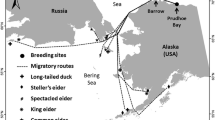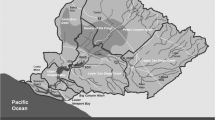Abstract
Trace contaminant concentrations were measured in eggs of endangered California clapper rails (Rallus longirostris obsoletus) collected from San Francisco Bay during 1975, 1986, and 1987, and in clapper rail eggs (R. l. waynei) from North Carolina during 1987. Residues of 10 detected organochlorines (OC) were low and decreased by 2 to 3-fold from 1975 to 1986–1987 for San Francisco Bay samples, whereas eggshell thickness remained unchanged and comparable to eggs collected prior to 1940. Mercury (Hg) concentrations in eggs from San Francisco Bay were higher than those from North Carolina, and comparable to concentrations associated with reproductive effects in other avian species. Selenium (Se) concentrations in eggs from San Francisco Bay were also higher than those from North Carolina, and were highest in a north San Francisco Bay marsh adjacent to an oil refinery. Individual Se concentrations were slightly lower than values associated with embryotoxicity in other rallids. We recommend additional research on the effects of these and other contaminants on California clapper rails and the restoration of rail habitat.
Similar content being viewed by others
References
Borg K, Wanntrop H, Erne K, Hanko E (1969) Alkyl mercury poisoning in terrestrial wildlife. Viltrevy 6:301–379
Connors PG, Anderlini VC, Risebrough RW, Gilbertson M, Hays H (1970) Investigations of heavy metals in common tern populations. Can Field Nat 89:157–162
Cutter GA (1987) Selenium behavior in the Sacramento-San Joaquin Estuary, California. Report to US Bur of Recl, Sacramento, CA, April, 40 pp
DeGroot DS (1927) The California clapper rail: its nesting habits, enemies, and habitat. Condor 29:259–270
Eddleman WR, Knopf FL, Meanley B, Reid FA, Zembal R (1988) Conservation of North American rallids. Wilson Bull 100:458–475
Gill R Jr (1979) Status and distribution of the California clapper rail (Rallus longirostris obsoletus). Calif Fish Game 65:36–49
Harvey TE (1988) Breeding biology of the California clapper rail in south San Francisco Bay. Trans West Sect Wildl Soc 24:98–104
Hayes SP, Phillips PT, Martin M, Stephenson M, Smith D, Linfield J (1985) State Mussel Watch Program/Marine Water Quality Program, 1983–1984. State Water Resources Control Board, Water Quality Monit Rep 85-2WQ
Hayes SP, Phillips PT (1986) State Mussel Watch Program/Marine Water Quality Program, 1984–1985. State Water Resources Control Board, Water Quality Monit Rep 86-3WQ
Heinz, GH (1979) Methylmercury: reproductive and behavioral effects on three generations of mallard ducks. J Wildl Manage 43:394–401
Heinz GH, Hoffman DJ, Krynitsky AJ, Weller DMG (1987) Reproduction in mallards fed selenium. Environ Toxicol Chem 6:423–433
Heinz GH, Hoffman DJ, Gold LG (1989) Impaired reproduction of mallards fed an organic form of selenium. J Wildl Manage 53:418–428
Henny CJ, Blus LJ, Krynitsky AJ, Bunck CM (1984) Current impact of DDE on black-crowned night-herons in the intermountain west. J Wildl Manage 48:1–3
Josselyn M (1983) The ecology of San Francisco Bay tidal marshes: A community profile. US Fish and Wildl Serv, Div of Biol Serv, Washington, DC, FWS/OBS-3/23, 102 pp
Klaas EE, Ohlendorf HM, and Cromartie E (1980) Organochlorine residues and shell thickness in eggs of the clapper rail. Pestic Monit J 14:90–94
Kozicky EL, Schmidt FV (1949) Nesting habits in the clapper rail of New Jersey. Auk 66:353–364
Luoma SN, Cain D (1979) Fluctuations of copper, zinc, and silver in tellinid clams as related to freshwater discharge in south San Francisco Bay. In: Conomos TI (ed) San Francisco Bay: The urbanized estuary. American Assoc. for the Advancement of Science, San Francisco, pp 231–246
Luoma SN, Cain D, Johansson C (1985) Temporal fluctuations of silver, copper, and zinc in the bivalve, Macoma balthica at five stations in south San Francisco Bay. Hydrobiol 129:109–120
Moffitt J (1941) Notes on the food of the California clapper rail. Condor 3:270–273
Nichols FH, Cloern JE, Luoma SN, Peterson DH (1986) The modification of an estuary. Science 231:567–573
Ohlendorf HM, Lowe RW, Kelly PR, Harvey TE (1986a) Selenium and heavy metals in San Francisco Bay diving ducks. J Wildl Manage 50:64–71
Ohlendorf HM, Hothem RL, Aldrich TW, Moore JF (1986b) Relationships between selenium concentrations and avian reproduction. Trans North Am Wildl Natl Res Conf 51:330–342
Ohlendorf HM, Hothem RL, Aldrich TW, Krynitsky AJ (1987) Selenium contamination of the grasslands, a major California waterfowl area. Sci Tot Environ 66:169–183
Ohlendorf HM, Custer TW, Lowe RW, Rigney M, Cromartie E (1988) Organochlorines and mercury in eggs of coastal terns and herons in California, USA. Colon Waterbirds 1:85–94
Ohlendorf HM, Marois KC, Lowe RW, Harvey TE, Kelly PR (1989) Environmental contaminants and diving ducks in San Francisco Bay. In: Howard AQ (ed) Selenium and agricultural drainage: Implications for San Francisco Bay and the California environment (Selenium IV). The Bay Institute of San Francisco, Sausalito, CA, pp 60–69
Peakall DB, Peakall ML (1973) Effect of polychlorinated biphenyl on the reproduction of artificially and naturally incubated dove eggs. J Appl Ecol 10:863–868
Phillips DJH (1987) Toxic contaminants in the San Francisco Bay-Delta and their possible biological effects. Aquatic Habitat Institute, Richmond, CA, 413 pp
Skorupa JP, Ohlendorf HM (1991) Contaminants in drainage water and avian risk thresholds. In: Dinar A, Zilberman D (eds) The economics and management of water and drainage in agriculture. Kluwer Academic Publishers, pp 345–368
Spann JW, Heath RG, Kreitzer JF, Locke LN (1972) Ethyl mercury p-toluene sulonanilide: Lethal and reproductive effects on pheasants. Sci 175:328–331
Stephenson M, Smith D, Ichikawa G, Goetzl J, Martin M (1986) State Mussel Watch Program/Marine Water Quality Monitoring Program: Preliminary data report, 1985–86. Rep of the California Dept of Fish and Game to the State Water Resour Control Board, July 2, 1986
Stickel L (1973) Pesticide residues in birds and mammals. In: Edwards CA (ed) Environmental pollution by pesticides. Plenum Press, London, pp 254–312
US Fish and Wildlife Service (1973) United States list of endangered fauna. US Fish and Wildlife Service, Office of Endangered Species and Intl Activities, 22 pp
— (1984) Salt marsh harvest mouse and California clapper rail recovery plan. US Fish and Wildl Serv Publ, Portland, OR, 130 pp
Author information
Authors and Affiliations
Rights and permissions
About this article
Cite this article
Lonzarich, D.G., Harvey, T.E. & Takekawa, J.E. Trace element and organochlorine concentrations in California clapper rail (Rallus longirostris obsoletus) eggs. Arch. Environ. Contam. Toxicol. 23, 147–153 (1992). https://doi.org/10.1007/BF00212268
Received:
Revised:
Issue Date:
DOI: https://doi.org/10.1007/BF00212268




